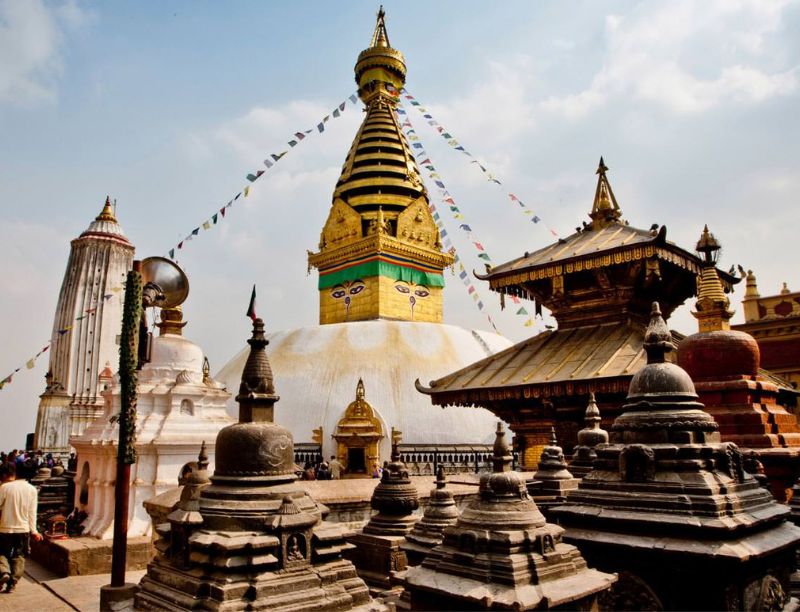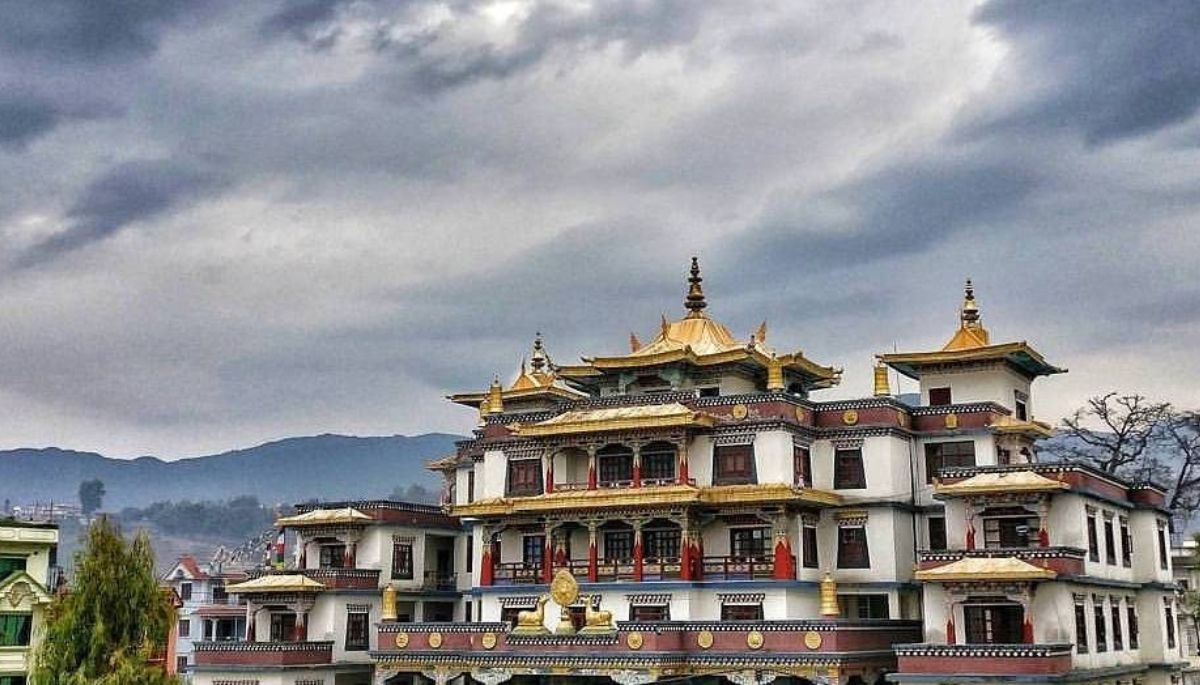Introduction
Hiking in the Kathmandu Valley offers a unique blend of natural beauty, cultural richness, and spiritual significance. One of the most rewarding hikes in the region is the journey from Ichangu Narayan to White Gumba, also known as Seto Gumba. This hike takes you through some of the most picturesque landscapes and offers a deep dive into Nepal’s cultural and religious heritage. The main route for this hike begins at the iconic Swayambhunath Stupa, leading to Ichangu Narayan and culminating at White Gumba.
Starting Point: Swayambhunath Stupa
The hike begins at the Swayambhunath Stupa, one of Nepal’s most revered Buddhist sites. Swayambhunath, also called the “Monkey Temple,” is situated on a hill and provides expansive views of the Kathmandu Valley. The stupa, a UNESCO World Heritage Site, represents peace and harmony. Historians believe that founders established the site more than 2,000 years ago, making it one of the oldest religious sites in Nepal.
Various shrines and temples surround the stupa, which is always bustling with pilgrims, tourists, and monkeys. The air is heavy with incense, while prayer wheels spin and monks chant, filling the space with tranquility. Before the hike, exploring the stupa and its surroundings is worth soaking in its spiritual energy.

From Swayambhunath to Ichangu Narayan
The trail from Swayambhunath to Ichangu Narayan is a gentle ascent through urban and rural settings. As you leave the stupa behind, the city’s noise gradually fades, replaced by the sounds of nature. The path winds through small villages, fields, and patches of forest, offering glimpses of the traditional lifestyle of the local people.
Ichangu Narayan is a small, peaceful village renowned for its historic Vishnu temple. The temple is one of the oldest in the Kathmandu Valley, believed to have been built in the Licchavi period (around the 5th to 8th centuries). It is an important pilgrimage site for Hindus and holds a special place in the hearts of the local people.
Also Read: Nagidada Hike: A Secret Gem Near to Kathmandu
The Ichangu Narayan Temple’s architecture is a fine example of traditional Nepali craftsmanship. The artisans decorate the temple with beautiful wood carvings, stone sculptures, and metalwork, showcasing the region’s artistic heritage. Devotees often fill the temple courtyard, offering prayers and offerings to the deity. The serene environment of Ichangu Narayan provides a perfect spot to take a break and reflect on the spiritual aspects of the journey.
The Hike from Ichangu Narayan to White Gumba
From Ichangu Narayan, the trail continues towards White Gumba, also known as Seto Gumba. This part of the hike is more challenging, with a steeper ascent as you move deeper into the hills. The trail passes through dense forests, with tall trees providing shade and coolness, making it a refreshing walk even on a warm day. The sound of singing birds and rustling foliage underfoot create a peaceful ambiance.
As you climb higher, the views become more expansive. On a clear day, you can see the majestic Himalayan range in the distance, with its snow-capped peaks glistening in the sunlight. The Kathmandu Valley spreads out below, with its patchwork of fields, villages, and towns. The higher altitude also changes the flora, with more wildflowers and different species of trees adding to the beauty of the landscape.
White Gumba is a Tibetan Buddhist monastery located on a hilltop, surrounded by lush greenery. The monastery is relatively new, built in the traditional Tibetan architectural style, and is known for its whitewashed walls, hence the name “White Gumba.” The monastery complex includes several buildings, including prayer halls, meditation rooms, and accommodation for monks.
The atmosphere at White Gumba is one of peace and serenity. The monastery is a place for meditation and reflection, and visitors are welcome to join in the daily prayers or sit quietly and absorb the tranquil surroundings. The panoramic views from the monastery are breathtaking, with the entire Kathmandu Valley visible on one side and the towering peaks of the Himalayas on the other.
Cultural and Spiritual Significance
The hike from Swayambhunath Stupa to White Gumba via Ichangu Narayan is both a spiritual and cultural pilgrimage. Each of the three main points on this route—Swayambhunath, Ichangu Narayan, and White Gumba—holds deep religious significance.
- Swayambhunath Stupa, with its combination of Buddhist and Hindu symbols, represents the unity of all faiths in Nepal. The stupa’s dome symbolizes the world, while the eyes of the Buddha painted on all four sides represent wisdom and compassion. The 13 steps of the spire above the dome signify enlightenment.
- Ichangu Narayan Temple is a sacred site for Hindus, particularly those who worship Lord Vishnu. The history and architecture of the temple reflect ancient traditions from the Licchavi period, and generations have passed down the rituals performed here.
- White Gumba is a center of Tibetan Buddhism, a place where the teachings of the Buddha are studied and practiced. The monastery’s serene setting is perfect for meditation, offering a peaceful retreat from daily life’s chaos.
Together, these sites create a spiritual journey that connects the past and present, the physical and the metaphysical. The hike encourages introspection, allowing hikers to connect with nature, history, and their inner selves.
Practical Information
For the Ichangu Narayan to White Gumba hike, consider practical tips for preparation, safety, and weather conditions.
- Distance and Duration: The hike from Swayambhunath to White Gumba via Ichangu Narayan is approximately 10 kilometers long. It typically takes about 4 to 5 hours to complete, depending on your pace and how much time you spend at each site.
- Best Time to Visit: The best time to undertake this hike is during the spring (March to May) and autumn seasons (September to November). The weather is pleasant and skies clear, providing the best views of the surrounding landscapes during these times.
- What to Bring: Comfortable walking shoes, water, snacks, and a camera are essential. It’s also a good idea to bring a hat and sunscreen, as parts of the trail are exposed to the sun. If you plan to visit the religious sites, modest clothing is recommended.
- Permits: No special permits are required for this hike, but carrying some identification and necessary health documents is always a good idea.
- Guides and Safety: The trail is well-marked, and it’s possible to do it independently. Hiring a local guide enhances your experience and ensures safety; stay on the trail and remain aware of your surroundings.
Conclusion
The hike from Swayambhunath Stupa to White Gumba via Ichangu Narayan is a journey that offers more than just physical exercise. It is a walk through history, culture, and spirituality, providing a unique opportunity to explore some of the most significant religious sites in the Kathmandu Valley while enjoying the region’s natural beauty. This hike caters to seasoned hikers and spiritual seekers alike, making it a must do for anyone visiting Nepal.
Reaching White Gumba reveals breathtaking views, making the journey as rewarding as the destination. The harmony of the natural world, cultural diversity, and spiritual depth make this hike an unforgettable experience.
Read More: Banasur Danda Hike: An Unforgettable Trek


0 Comment